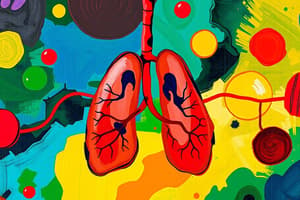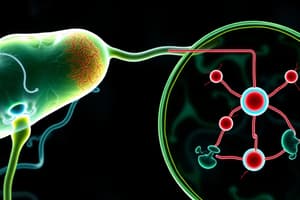Podcast
Questions and Answers
What is the main product of glycolysis from one glucose molecule?
What is the main product of glycolysis from one glucose molecule?
- 2 Acetyl Co-A
- 2 Pyruvate (correct)
- 2 NADH
- 4 ATP
Which of the following stages of cellular respiration does not require oxygen?
Which of the following stages of cellular respiration does not require oxygen?
- Kreb’s Cycle
- Glycolysis (correct)
- Electron Transport Chain
- Pyruvate Oxidation
What happens to pyruvate in the presence of oxygen?
What happens to pyruvate in the presence of oxygen?
- It is converted to Ethanol
- It is converted to Acetyl Co-A (correct)
- It undergoes Lactic Acid Fermentation
- It remains unchanged
What is produced during Lactic Acid Fermentation?
What is produced during Lactic Acid Fermentation?
How many total ATP molecules are produced during glycolysis?
How many total ATP molecules are produced during glycolysis?
Which statement about the Kreb’s Cycle is true?
Which statement about the Kreb’s Cycle is true?
What is the role of NAD+ in cellular respiration?
What is the role of NAD+ in cellular respiration?
What is produced as a waste product during pyruvate oxidation?
What is produced as a waste product during pyruvate oxidation?
What is the relationship between ATP synthesis and electron transport?
What is the relationship between ATP synthesis and electron transport?
How many ATP are theoretically produced from the complete oxidation of one molecule of glucose?
How many ATP are theoretically produced from the complete oxidation of one molecule of glucose?
What is the actual yield of ATP after the complete oxidation of one molecule of glucose?
What is the actual yield of ATP after the complete oxidation of one molecule of glucose?
What factor contributes to the loss of protons during ATP synthesis?
What factor contributes to the loss of protons during ATP synthesis?
What is the overall efficiency of ATP production from one molecule of glucose?
What is the overall efficiency of ATP production from one molecule of glucose?
What is the main purpose of the electron transport chain?
What is the main purpose of the electron transport chain?
How many protons does every NADH pump across the membrane?
How many protons does every NADH pump across the membrane?
Which molecule serves as the final electron acceptor in the electron transport chain?
Which molecule serves as the final electron acceptor in the electron transport chain?
What is created as a byproduct of the electron transport chain?
What is created as a byproduct of the electron transport chain?
During chemiosmosis, protons diffuse through which structure to generate ATP?
During chemiosmosis, protons diffuse through which structure to generate ATP?
How many ATP are produced from one molecule of FADH2?
How many ATP are produced from one molecule of FADH2?
Which of the following occurs during the Krebs cycle?
Which of the following occurs during the Krebs cycle?
What does the accumulation of protons in the inner membrane space create?
What does the accumulation of protons in the inner membrane space create?
Flashcards are hidden until you start studying
Study Notes
Cellular Respiration
- Process of transferring chemical energy from glucose to ATP.
- Occurs in several stages.
Stage 1: Glycolysis
- Occurs in the cytoplasm of the cell.
- Anaerobic process, doesn't require oxygen.
- Breaks down one molecule of 6-carbon glucose into two molecules of 3-carbon pyruvate.
- Produces a net gain of 2 ATP molecules (4 ATP produced, but 2 are used in the process).
- Creates NADH, which carries energy in the form of electrons and hydrogen.
Stage 2: Pyruvate Oxidation
- Occurs in the matrix of the mitochondria.
- Requires oxygen.
- Each pyruvate molecule is converted into acetyl-CoA, generating carbon dioxide (CO2), NADH, and hydrogen ions (H+).
Stage 3: Krebs Cycle (Citric Acid Cycle)
- Occurs in the mitochondrial matrix.
- Requires oxygen.
- Series of redox reactions that transfer energy to NAD and FAD, reducing them to NADH and FADH2.
- Occurs twice for every glucose molecule.
- Produces 6 NADH, 2 FADH2, and 2 ATP.
Stage 4: Electron Transport Chain
- Occurs on the inner mitochondrial membrane.
- Oxygen serves as the final electron acceptor.
- Series of proteins arranged in increasing order of electronegativity, accepting electrons from NADH and FADH2.
- Energy released from electron transfer is used to pump protons into the intermembrane space, creating an electrochemical gradient.
- This gradient is used to generate ATP through chemiosmosis.
- For every NADH entering the ETC, 6 H+ are pumped across the membrane, producing 3 ATP.
- For every FADH2 entering the ETC, 4 H+ are pumped across the membrane, producing 2 ATP.
Chemiosmosis
- Protons accumulate in the intermembrane space, creating an electrochemical gradient.
- Protons diffuse through a protein channel (ATPase) in the membrane, releasing energy that drives ATP synthesis.
- ATP synthesis is coupled with electron transport, both processes relying on glucose and oxygen.
ATP Yield
- Theoretical yield from 1 glucose molecule is 36 ATP.
- Actual yield is approximately 30 ATP, due to proton leakage and other cellular energy needs.
Overall Efficiency
- Cellular respiration is approximately 32% efficient in converting the energy from glucose into ATP.
Studying That Suits You
Use AI to generate personalized quizzes and flashcards to suit your learning preferences.




